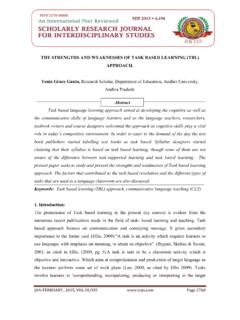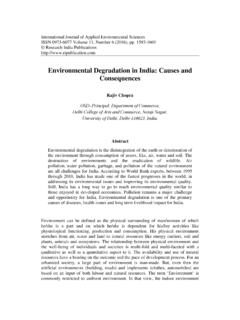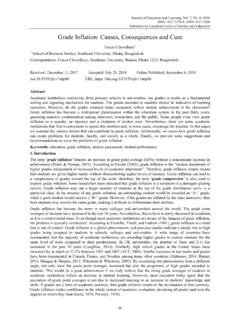Transcription of Natural Disasters: Causes, Consequences and Its Preventive ...
1 The International Journal of Indian Psychology ISSN 2348-5396 (e) | ISSN: 2349-3429 (p) Volume 3, Issue 3, No. 4, DIP: ISBN: 978-1-365-03420-6 | April - June, 2016 2016 I R Lone, S Subramani; licensee IJIP. This is an Open Access Research distributed under the terms of the Creative Commons Attribution License ( ), which permits unrestricted use, distribution, and reproduction in any Medium, provided the original work is properly cited. Natural Disasters: causes , Consequences and Its Preventive Role in Sustainable Development Rayees Ibrahim Lone1*, Dr. S. Subramani2 ABSTRACT Disaster is defined as a crisis situation causing wide spread damage which far exceeds our ability to recover.
2 Disaster is a sudden, calamitous event bringing great damage, loss, destruction and devastation to life and property. The damage caused by disaster is immeasurable and varies with the geographical location, climate and the type of the earth surface. Natural disasters are relatively sudden and cause large scale, widespread death, loss of property and disturbance to social systems and life over which people have a little or no control. Thus, any event can be classed as disaster when the magnitude of destruction and damage caused by it is very high. Communities will always face Natural hazards, but today s disasters are often generated by, or at least exacerbated by, human activities.
3 At the most dramatic level, human activities are changing the Natural balance of the earth, interfering as never before with the atmosphere, the oceans, the polar ice caps, the forest cover and the Natural pillars that make our world a liveable home. But we are also putting ourselves in harm s way in less visible ways. This paper seeks to determine the Natural disasters, causes and Consequences and its prevention. Nature is bountiful full of resources used by the living organisms use for their survival and well-being. But nature has its own control systems. Resources used up are replenished excesses are checked, all naturally through the biogeochemical cycles, the food chains and webs and other Natural phenomena.
4 Thus equilibrium is maintained in nature. This is called ecological balance and has in recent times been disturbed by human activities. Keywords: Natural disaster, Earthquake, Flood, Tsunami, Drought, Hurricane, Avalanches. Disaster is an undesirable occurrence resulting from forces that are largely outside human control, strikes quickly with little or no warning, which causes or threatens serious disruption of life and property including death and injury to a large number of people, and requires therefore, mobilisation of efforts in excess of that which are normally provided by statutory emergency services.
5 As compared to Natural hazards, Natural disasters are relatively sudden and cause large 1 Department of Sociology, Annamalai University, Annamalainagar, Tamil Nadu 2 Department of Sociology, Annamalai University, Annamalainagar, Tamil Nadu *Responding Author Natural Disasters: causes , Consequences and Its Preventive Role in Sustainable Development The International Journal of Indian Psychology, ISSN 2348-5396 (e)| ISSN: 2349-3429 (p) | 58 scale, widespread death, loss of property and disturbance to social systems and life over which people have a little or no control.
6 Thus, any event can be classed as disaster when the magnitude of destruction and damage caused by it is very high. A Natural hazard is an atmospheric or hydrological and geophysical, event ( , Flood or Drought, Earthquake, Tsunami, Landslide, Windstorm,) that has the potential to cause harm or loss, however a Natural disaster is the occurrence of an extreme hazardous event that impacts on communities causing damage, disruption and casualties, and leaving the affected communities unable to function normally without outside assistance (Twig, 2007). According to the Centre for Research on the Epidemiology of Disasters (2013) annual disaster statistics review, 357 Natural disasters occurred worldwide in the year 2012, which was less than the average Natural disaster frequency from 2002 to 2011(394).
7 9,655 people were killed in 2012 by Natural disasters and million people were affected globally. Hydro-meteorological disasters accounted for 74% (US$ trillion) of total reported losses, 87% (18,200) of total disaster events, and 61% ( million) of total lives lost. From 1980 to 2012, disaster-related losses amounted to US$3,800 billion worldwide. Some 87% of these reported disasters (18,200 events), 74% of losses (US$2,800 billion (Munich Re 2013). The economic damages from Natural disasters in 2012 were estimated at US$ 157 billion. Since 1960, in the all over the world Natural disasters have resulted in the loss of more than three million lives and affected many more.)
8 90% of the Natural disasters and 95% of the total disaster related deaths occur only in developing countries. It is because most of the world s worst disasters tend to occur between the area of Tropic of Cancer and the Tropic of Capricorn. The Natural disasters directly impact economies, agriculture, food security, water, sanitation, the environment and health each year. Therefore it is one of the single largest concerns for most of the developing nations. Different Natural hazards cause varying levels of physical damage to infrastructure and agriculture with implications for their indirect and secondary impacts.
9 Drought causes heavy Crop and Livestock losses over wide areas of land but typically leave infrastructure and productive capacity largely unaffected. Floods and Cyclones cause extensive whereas damage to both infrastructure and agriculture, depending on their timing relative to the agricultural cycle. While Earthquakes have little impact on standing crops excluding localized losses but can cause wide spread devastation of infrastructure and other productive capacity over relatively large areas. India is hit by one major Natural disaster or the other almost every year where in the loss of life is accompanied by losses of the magnitude that is difficult to comprehend.
10 The decade (1990-99), which was the International Decade for Natural Disaster Reduction (1990-99), it witnessed a spate of large-scale disasters that defied all attempts to stem them. Natural Disasters: causes , Consequences and Its Preventive Role in Sustainable Development The International Journal of Indian Psychology, ISSN 2348-5396 (e)| ISSN: 2349-3429 (p) | 59 REVIEW OF LITERATURE Effective community participation is an educational and empowering process whereby communities identify the problems and needs and assume responsibility to plan, manage, control and assess the collective action that are necessary.













